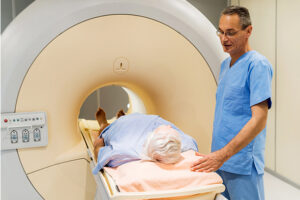Oncology
Prostate Cancer
Monitoring for the Transition From Nonmetastatic Castration-Resistant Prostate Cancer to Detectable Metastatic Disease
Overview
Determining how frequently and how best to monitor for the progression from nonmetastatic castration-resistant prostate cancer (nmCRPC) to detectable metastatic disease is a subject that continues to be debated and remains somewhat of an art form. With the recent US Food and Drug Administration (FDA) approval of the second-generation androgen receptor (AR) antagonists apalutamide, enzalutamide, and darolutamide for nmCRPC, there may be a place for next-generation imaging (NGI) in the monitoring of patients with nmCRPC.
What are the best practices for monitoring patients with nmCRPC, and how does the emergence of symptoms factor into this equation?
Expert Commentary
Daniel P. Petrylak, MD
|
|
“It is important to monitor individuals who develop symptoms, even if their PSA levels have decreased. In some patients, a particular phenotype can transform and there may be progression without a PSA rise.”
Factors that influence when to monitor patients for the progression from nmCRPC to detectable metastatic disease include prostate-specific antigen (PSA) level and patient symptoms. Dr Gomella and I took part in the development of the RADAR I recommendations, which offer a single framework from which monitoring can be approached. That is, the first set of conventional imaging studies, such as bone scan and computed tomography (CT) or magnetic resonance imaging (MRI), should be performed when the PSA level reaches 2 ng/mL. If the imaging study is negative and the patient remains asymptomatic, you can rescan the patient when the PSA level reaches 5 ng/mL and then again after every doubling of the PSA, with PSA testing every 3 months for asymptomatic men (nmCRPC). For symptomatic patients, regardless of their PSA levels, clinical judgment is applied to determine the appropriate next steps. Further, it is important to monitor individuals who develop symptoms, even if their PSA levels have decreased. In some patients, a particular phenotype can transform and there may be progression without a PSA rise.
The use of positron emission tomography (PET)/CT or PET/MRI in prostate cancer has evolved with the availability of more specific prostate cancer radioactive tracers, including, but not limited to, 18F-FACBC, 68Gallium prostate-specific membrane antigen (PSMA), and 11C-choline. The use of such NGI techniques raises some interesting and important questions. If, for instance, if you have a finding on PSMA PET/CT that does not appear on conventional imaging, how do you proceed? Do you irradiate that newly detected lesion? If the patient is not on hormone therapy (ie, in the hormone-sensitive state), do you start him on systemic therapies earlier, owing to those findings on NGI?
In these trials with second-generation AR antagonists, the definitions were based on conventional imaging. In the ARAMIS trial, the presence of pelvic lymph nodes less than 2 cm in diameter in the short axis below the aortic bifurcation was allowed. Further, the best use of the different NGI techniques in clinical practice is something that is still being defined, in consideration of their varying sensitivities and specificities. As these are emerging imaging technologies, there is currently neither the evidence base nor the expert consensus to say definitively which course of action may optimize outcomes in these patients when low-volume disease is detected using NGI. There is no doubt that these are important research questions, because we know that all treatments in this space carry the potential for significant side effects that can cause morbidity in our patients.
Expert Commentary
Leonard Gomella, MD
|
|
“These NGI techniques are going to be the next revolution in the management of all stages of prostate cancer disease, from early disease to late stages of disease, with perhaps the biggest impact in the nmCRPC space.”
We are in a transitional period in several respects. First, over the last 2 years or so, the concept of the nmCRPC disease state has been in transition. Second, we are in the midst of a major transition with respect to imaging in the field of prostate cancer. We have NGI agents that are already FDA approved, such as 18F-FACBC, and others that are still in clinical trials and are awaiting FDA approval here in the United States, although some of these have become widely used outside the United States and have become somewhat of a standard of care internationally. These NGI techniques are going to be the next revolution in the management of all stages of prostate cancer disease, from early disease to late stages of disease, with perhaps the biggest impact in the nmCRPC space. For instance, lymph node involvement may not be appreciated on CT or MRI unless the lymph nodes are obviously enlarged (>1.0-1.5 cm) with metastatic disease. With NGI, however, we can detect much smaller malignant lesions within normal-sized lymph nodes, sometimes at PSA values as low as 0.2 to 0.5 ng/mL; so, this is not only going to have an impact on advanced disease but also the earlier stages.
Although NGI offers earlier detection, the widespread use of these techniques may be limited by cost and by the availability of large cyclotrons to develop the radioactive tracers. Something like 68Gallium can be created relatively easily with a generator in a nuclear medicine department, while 11C-choline requires a large cyclotron. There are numerous PET agents in use and in development, with 18F-FACBC and 68Gallium PSMA likely attracting the most attention right now. However, even when FDA-approved scans are readily available, patient access is not a forgone conclusion; in fact, insurance companies often will not cover such imaging.
It is also important to note that the clinical trials in nmCRPC that led to the recent FDA approval of the second-generation AR antagonists apalutamide, enzalutamide, and darolutamide used conventional imaging for staging. Although there is some evidence that suggests a positive impact with early intervention in patients with low disease burden, further evaluation is needed to determine whether NGI coupled with early metastasis-directed therapy will lead to improved overall survival in patients with nmCRPC.
References
Crawford ED, Koo PJ, Shore N, et al; RADAR III Group. A clinician’s guide to next generation imaging in patients with advanced prostate cancer (RADAR III). J Urol. 2019;201(4):682-692.
Evans JD, Jethwa KR, Ost P, et al. Prostate cancer-specific PET radiotracers: a review on the clinical utility in recurrent disease. Pract Radiat Oncol. 2018;8(1):28-39.
Fizazi K, Shore N, Tammela TL, et al; ARAMIS Investigators. Darolutamide in nonmetastatic, castration-resistant prostate cancer. N Engl J Med. 2019;380(13):1235-1246.
Gillessen S, Attard G, Beer TM, et al. Management of patients with advanced prostate cancer: report of the Advanced Prostate Cancer Consensus Conference 2019. Eur Urol. 2020;77(4):508-547.
Heidegger I, Brandt MP, Heck MM. Treatment of non-metastatic castration resistant prostate cancer in 2020: what is the best? Urol Oncol. 2020 Jan 15. pii: S1078-1439(19)30480-6. doi: 10.1016/j.urolonc.2019.11.007. [Epub ahead of print]
Hussain M, Fizazi K, Saad F, et al. Enzalutamide in men with nonmetastatic, castration-resistant prostate cancer. N Engl J Med. 2018;378(26):2465-2474.
Mateo J, Fizazi K, Gillessen S, et al. Managing nonmetastatic castration-resistant prostate cancer. Eur Urol. 2019;75(2):285-293.
Smith MR, Saad F, Chowdhury S, et al; SPARTAN Investigators. Apalutamide treatment and metastasis-free survival in prostate cancer. N Engl J Med. 2018;378(15):1408-1418.
Trabulsi EJ, Rumble RB, Jadvar H, et al. Optimum imaging strategies for advanced prostate cancer: ASCO guideline. J Clin Oncol. 2020 Jan 15:JCO1902757. doi: 10.1200/JCO.19.02757. [Epub ahead of print]












